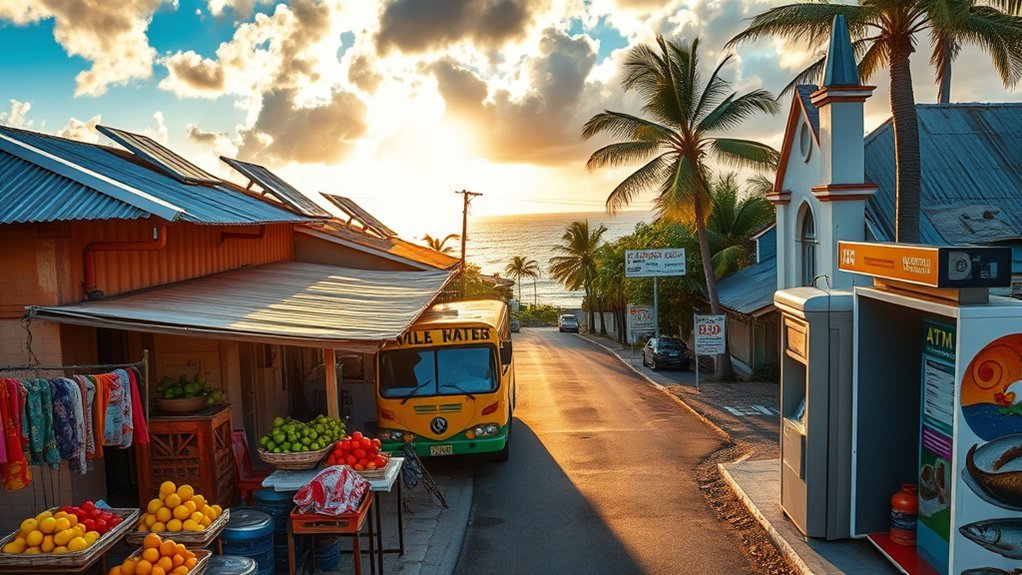You’ll find living in Samoa is much cheaper than in the U.S.; a single person typically spends about 4,795 Tala monthly while a family of four averages roughly 9,143 Tala. Rent for one-bedrooms often falls under $400, utilities run very low (around 16.8 Tala for families), and groceries and local dining are affordable. Transport and internet are modest costs, though mortgages and some health procedures can be pricier—keep going and you’ll get precise breakdowns and comparisons.
Monthly Living Expenses Breakdown for Individuals and Families
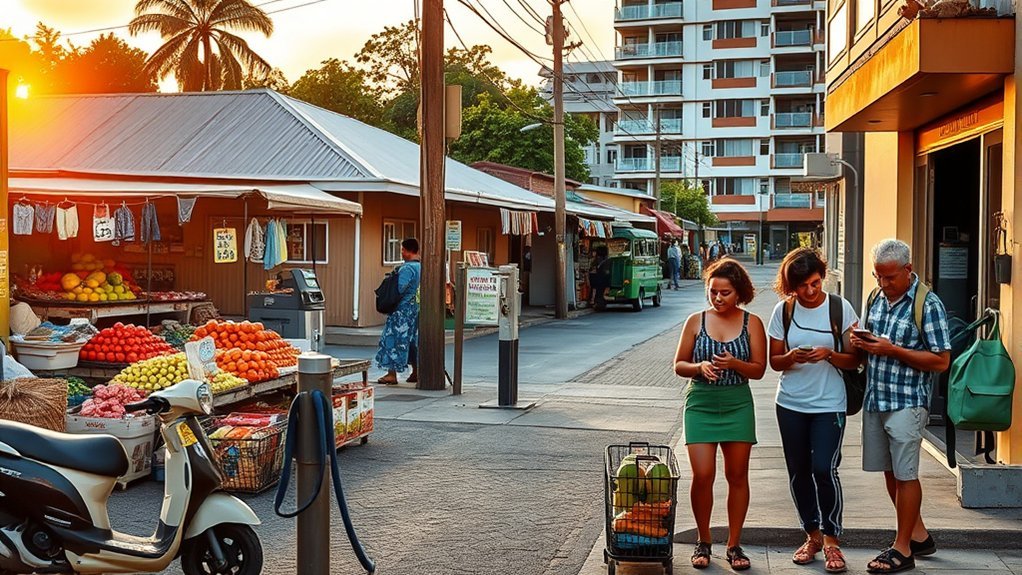
One clear way to gauge living costs in Samoa is to compare typical monthly budgets: a single person spends about 4,795 Tala while a family of four averages around 9,143 Tala, reflecting economies of scale on items like food and utilities.
You’ll see that per-person costs drop as fixed expenses spread across members: utilities for a family run about 16.8 Tala monthly, a negligible per-capita item compared with individual budgets.
Food shows mixed effects—12 large eggs cost 10 Tala and 1 kg of tomatoes is 20 Tala—so bulk buying benefits families.
Transport remains proportional: gas at 2.63 Tala per liter and local tickets at 3.55 Tala affect both households and singles based on travel frequency.
Dining out is affordable for occasional outings—a basic dinner for two costs ~93 Tala.
Use a cost of living calculator to model your specific mix of groceries, transport and dining to see whether you align closer to single or family averages.
Housing and Rental Prices in Apia and Beyond

Although housing in Apia won’t match the scale of U.S. metros, you’ll find much lower rents and purchase costs: two-bedroom apartments rent far below typical U.S. prices, studios or one-bedrooms can be had for $400 or less depending on location and amenities, and city-center land runs about $1,414 per m² versus roughly $4,491 per m² in the U.S., with suburban lots around $963 per m² offering an even cheaper alternative; utilities for a family average only about 16.8 Tala monthly compared with $193 in the U.S., further reducing monthly living costs.
You’ll notice housing here is compact, market-driven, and oriented to local incomes. Buying in Apia saves you thousands per square meter versus U.S. cities; suburban parcels cut costs further if you prioritize space over centrality.
Rental inventory favors short leases and modest finishes, so factor maintenance and occasional power constraints into comparisons.
For quick reference:
- Two-bedroom rentals: substantially cheaper than U.S. averages.
- Studios/one-bedrooms: often ≤ $400, depending on amenities.
- Land prices: city ≈ $1,414/m²; suburbs ≈ $963/m².
Grocery and Food Costs: Markets, Restaurants, and Staples
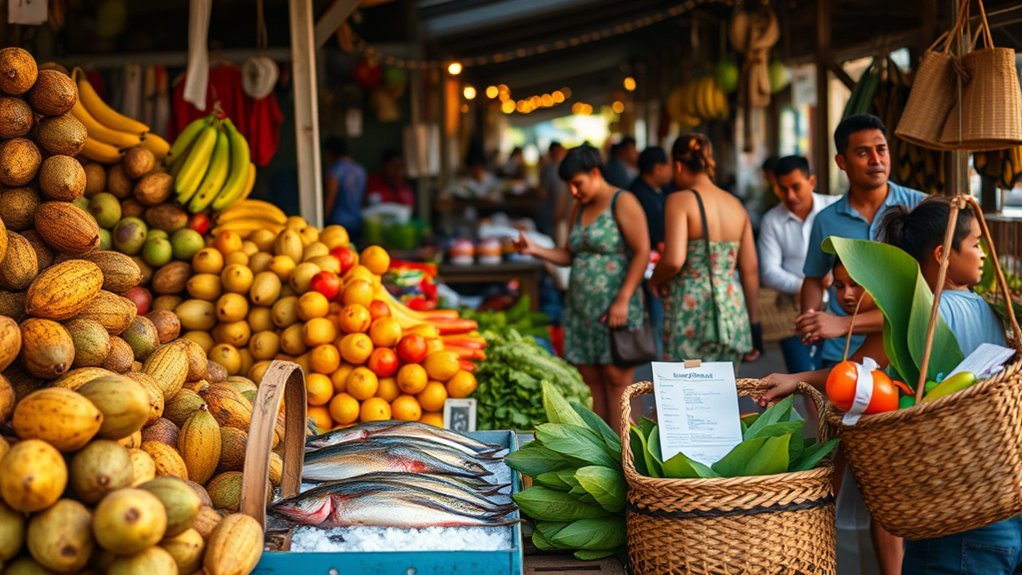
After you’ve sized up housing costs, consider how grocery and dining prices shape monthly budgets in Samoa.
You’ll find staples are generally inexpensive: 12 large eggs cost about 10 Tala, 1 kg potatoes 8 Tala, and 1 kg apples a strikingly low 3 Tala.
Vegetables like tomatoes run about 20 Tala per kg, while a 500 g block of local cheese is 23 Tala. These prices keep basic grocery spending modest compared with many countries, lowering your overall cost of living if you cook at home.
Eating out lifts expenses: a basic dinner for two at a neighborhood pub averages 93 Tala, while an Italian dinner with wine is around 149 Tala.
Fast-food meals in Samoa align with U.S. prices — roughly $11.80 versus $11.50 — so frequent convenience dining can erode savings.
Plan a mix of market shopping and occasional restaurants to balance quality, convenience, and your monthly grocery budget.
Transportation, Fuel, and Local Travel Expenses

You’ll notice fuel is relatively costly at about 2.63 Tala per liter, higher than typical U.S. prices, which affects driving budgets and vehicle running costs.
Local transport tickets run roughly 3.55 Tala per ride with a monthly pass around 22.3 Tala, making public transit an economical alternative for regular commuters.
Vehicle purchase prices vary widely, so compare fuel-driven running costs against ticketed transport when estimating your monthly travel spend.
Fuel Prices and Trends
One liter of gas in Samoa runs about 2.63 Tala, so if you drive regularly that higher-than-average price will noticeably raise your monthly transport costs compared with many neighboring countries.
You’ll find fuel prices in Samoa above regional averages, so owning and operating a car costs more than relying on short public trips.
- Compare: fuel prices at 2.63 Tala/L vs. lower rates in nearby islands — you pay a premium that scales with kilometers driven.
- Offset: local transport tickets (~3.55 Tala per trip) make short journeys inexpensive, so you can reduce fuel spend by choosing buses for daily commutes.
- Vehicle cost uncertainty: new car prices vary, so factor ongoing fuel premiums into total ownership cost projections.
Local Transport Costs
Fuel and vehicle costs in Samoa push up personal transport expenses, but you can cut overall spending by using the area’s inexpensive local tickets. A single local transport ticket runs about 3.55 Tala and a monthly pass averages 22.3 Tala, so you’ll find short trips and regular commutes affordable compared with many U.S. cities.
Petrol is around 2.63 Tala per liter, higher than U.S. averages, so driving becomes costly and raises your local transport costs and household Cost of Living Index. Public transport exists and is practical for routine travel; for short visits you can also weigh taxi or ride choices against a 37 Tala private doctor consultation when budgeting daily life.
Utilities, Internet, and Household Services

Although Samoa’s utility and internet costs are much lower than in the U.S., access and consumption patterns shape what you actually pay: average family utility bills run about 16.8 Tala versus 193 Tala in the U.S., and typical internet plans cost roughly 35.7 Tala compared with 67.5 Tala.
However, some areas face limited reliability and fewer provider choices that can affect monthly expenses depending on household size and usage. You’ll find basic household services — water, electricity, modest internet — contribute little to the average cost of living compared with many U.S. cities, but variability matters.
If you consume more power or need stable high-speed internet, costs and options change. Consider these practical points:
- Smaller households: lower utility bills (near 16.8 Tala) but per-person costs can rise with inefficient appliances.
- Internet reliability: 35.7 Tala average, yet remote areas may need backup solutions that increase monthly spend.
- Service availability: fewer providers can limit competition, affecting prices and upgrade options.
Healthcare, Insurance, and Medical Costs
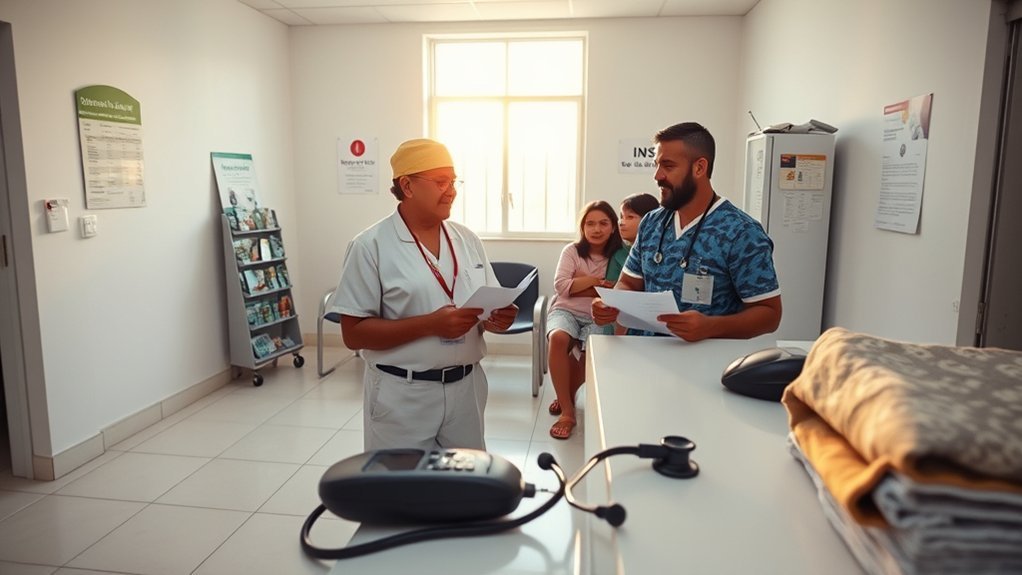
When you compare options in Samoa, public healthcare provides basic access while private clinics charge about 37 Tala for a 15-minute visit, making short consultations affordable by regional standards.
Common medications are cheap — a 6-day cold treatment runs around 3 Tala — but total costs scale with family size and specific treatments.
Insurance plans and group benefits are available and are assessed alongside out-of-pocket expenses to give a clearer picture of your likely annual medical spend.
Public Healthcare Access
If you rely on Samoa’s public system, expect a mix of government-run clinics and private providers where a short private consultation runs about 37 Tala for 15 minutes. The National Health Service aims to keep basic care affordable, with common items like a six‑day supply of cold medicine costing roughly 3 Tala.
You’ll find lower out-of-pocket costs for minor ailments compared with many countries, but service quality and availability vary by location. Rural residents often travel to Apia for diagnostics or specialist referrals.
Health insurance isn’t mandatory, yet it can protect you from higher expenses during serious illness or emergencies—factor it into your living expenses planning.
- Urban access: better facilities, shorter wait times.
- Rural access: limited services, higher travel costs.
- Cost profile: low routine costs, riskier for major care.
Private Clinic Fees
Because private clinics set their own rates, expect a typical 15‑minute consultation to cost about 37 Tala and additional services to raise out‑of‑pocket expenses quickly, so budget accordingly compared with lower routine costs like a 3‑Tala six‑day cold medicine supply; private pricing can vary widely, may not be transparent, and international insurance often won’t cover all charges, making local or supplemental health insurance advisable. You’ll face variable private clinic fees for tests, procedures, and prescriptions, so compare providers when possible. Below is a simple comparative snapshot to plan out-of-pocket spend:
| Service | Typical private cost (Tala) | Notes |
|---|---|---|
| 15‑min consult | 37 | Base rate |
| Cold meds (6 days) | 3 | Low routine cost |
| Basic test | 100 | Varies |
| Minor procedure | 250 | Can rise quickly |
Insurance Availability and Costs
Although thorough plans exist, you’ll often rely on a mix of limited local policies, private top-ups, and out‑of‑pocket payments. A short private GP visit runs about 37 Tala for 15 minutes, routine meds can be as low as 3 Tala, while tests and procedures climb into the hundreds.
So compare local carrier group benefits, supplemental private insurance, and expected family-level costs to judge real affordability and coverage gaps. You should assess insurance availability, coverage limits, exclusions, and premium vs. expected spend.
National carriers track group medical benefits that feed the health care score; use that to benchmark affordability. Many people top up with private plans or pay directly when local policies don’t cover procedures, dental, or chronic meds.
- Compare group vs private premiums and limits.
- Estimate family out‑of‑pocket yearly costs.
- Check exclusions and claim turnaround.
Entertainment, Dining Out, and Leisure Activities
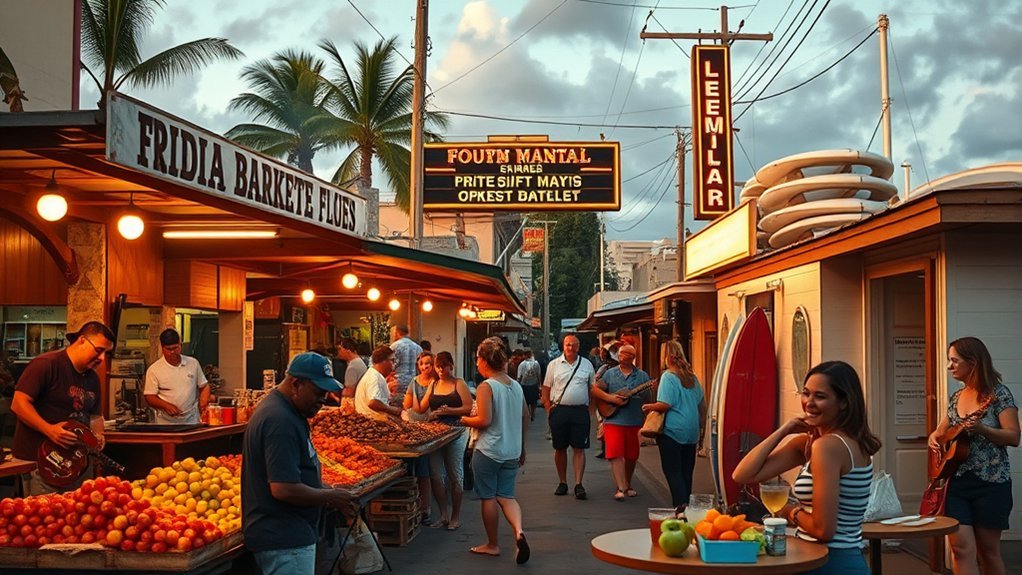
When you go out in Samoa, you’ll find dining and leisure costs are noticeably lower than in many Western countries: a basic pub dinner for two runs about 93 Tala and an Italian dinner with wine about 149 Tala, compared with roughly $35.90 and $76.50 average U.S. equivalents, respectively.
You’ll pay about 32 Tala for two movie tickets, so cinema outings are inexpensive. A cocktail in a downtown club costs roughly 15 Tala, making nightlife affordable if you’re conscious of spending.
Coffee culture is cheap too: a cappuccino in the expat area is about 10 Tala, well below many Western prices.
Overall Cost of eating and entertainment in Samoa trends lower across common categories, so you can maintain an active social life without large expenditures.
If you prioritize local venues and modest menus, your leisure budget will stretch further than in many high-cost countries, allowing frequent dining, movies, and casual nights out with minimal financial strain.
Salary Adjustments, Purchasing Power, and Cost Comparison With the United States
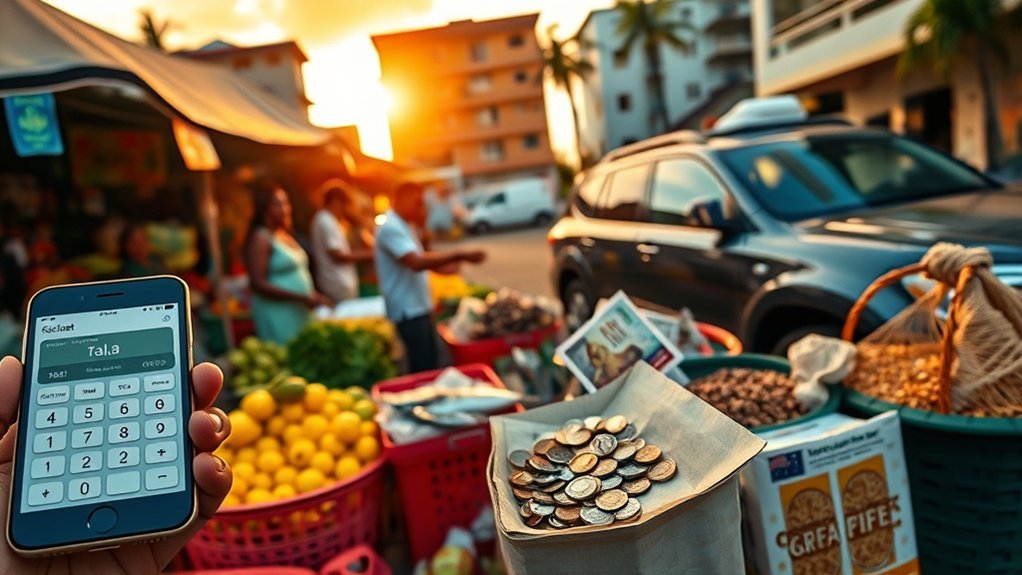
After seeing how affordable dining and leisure are, it’s useful to look at how wages and buying power stack up against the U.S. You’ll find mixed signals in the cost comparison: everyday items and services tend to be cheaper, but borrowing and some fares can erode purchasing power.
Everyday costs are lower, boosting local buying power, yet higher borrowing and certain fares can offset those gains.
- Dining & transport: A basic dinner for two is about $35.90 in Samoa vs. $76.50 in the U.S.; a monthly public transport pass is $22.30 vs. $69.50 — both boost local purchasing power relative to U.S. wages.
- Utilities & fares: Monthly utilities average $16.80 in Samoa versus $193 in the U.S., improving disposable income, but a single local transport ticket costs $3.55 in Samoa compared with $2.35 in the U.S., showing uneven pricing effects.
- Credit costs: Mortgage rates run 11.59% in Samoa versus 6.41% in the U.S., meaning higher borrowing costs can reduce long-term purchasing power despite lower everyday expenses.
Frequently Asked Questions
Can a US Citizen Live in Samoa?
Yes — you can. You’ll get a 60-day visitor permit, can extend it, or pursue residency through employment or long-term arrangements. Compare costs, healthcare access, and housing options to decide if Samoa fits your needs.
How Much Does a House Cost in American Samoa?
You’re looking at roughly $963 per square meter for suburban homes in American Samoa, which is considerably gentler than the U.S. mainland average of $3,675/m²; rentals often hover around $400/month, varying by location.
How Much Is a Coke in Samoa?
A Coke in Samoa costs about 3 Tala (0.33 L) at stores and roughly 4 Tala in cafes/restaurants; that’s generally cheaper than the U.S. average (~$1.50), though urban spots like Apia may charge slightly more.
How Long Can a US Citizen Stay in Samoa?
You can stay in Samoa 60 days visa-free as a US citizen, and you can request a 30-day extension (total 90 days) by showing passport, onward travel, and justification; overstays risk fines and travel complications.
Conclusion
You’ll find living in Samoa is cheaper than many U.S. cities—rent and groceries run about 40–60% lower—but wages are also considerably lower, so purchasing power depends on income source. If you earn a foreign or remote salary, your dollar stretches further; if you rely on local pay, costs can feel tight. The data disproves the “tropical paradise is cheap for everyone” theory: affordability hinges on where your income comes from, not just lower prices.

